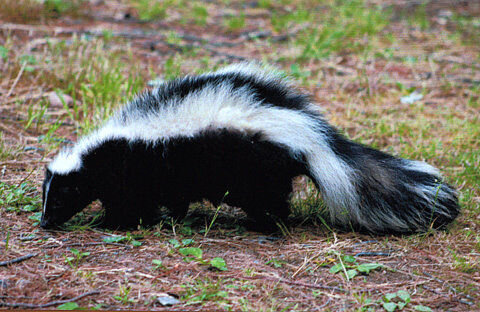New Mutant Monday #103 - Stinkers

The mutated descendants of the common Skunk, these creatures are outright terrifying to those who encounter them. They have changed little from their ancestors, except that they are slightly larger, and instead of a pair of white-stripes down their back, they have three stripes.
Each specimen is approximately two feet in length, and weigh about ten pounds. They have sharp teeth and claws that are made for digging and pulling apart roots and rotten trunks to get at insects and grubs that are the staple of their diet.
The mutated descendants of the common Skunk, these creatures are outright terrifying to those who encounter them. They have changed little from their ancestors, except that they are slightly larger, and instead of a pair of white-stripes down their back, they have three stripes.
Each specimen is approximately two feet in length, and weigh about ten pounds. They have sharp teeth and claws that are made for digging and pulling apart roots and rotten trunks to get at insects and grubs that are the staple of their diet.
Like their ancestors, when confronted with potential danger, these creatures will turn and present their rear to the attacker, and then shoot out a highly toxic and caustic stream of foul liquid. However, unlike their ancestors whose defensive spray merely stunk to high heaven, the spray produced by these creatures is acidic and highly flammable, on top of the nauseating stench.
When attacked, they can spray this toxic blend at targets up to 50 feet away. This is considered a ranged attack and will affect only a single target. If the attack hits, then the acid begins to work, causing an initial 3d6 points of damage. This damage will be reduced by 1d6 per round until the acid is no longer effective. To make matters worse, if the target is carrying an open flame, or uses any weapon that produces thermal damage, the spray will instantly explode, causing 6d6 damage to anyone in a 15 foot radius from the target. This will automatically neutralize the acid, rendering it harmless.
If that was not bad enough, the target must make a saving throw versus poison or become nauseated from the stench. This will last for 4d6 turns, at which time the victim will finally adjust to the smell. Anyone with the increased senses (smell) mutation suffer a -4 to the save and the duration is doubled!
The spray can be washed off by any sort of liquid that contains citric acid, or even alcohol. If left unchecked, the victim will stink so badly that anyone who comes within 15 feet must make a saving throw versus poison or become nauseated until they leave the area of effect. After that time, the nausea will wear off in 1d4 rounds.
They can use this attack once every three rounds, and have enough toxic spray for 2d4 uses. Their bodies produce enough of the spray to replenish 1d4 doses per day if they use all of the toxic chemical.
The creatures are very curious, and love to sneak into camps and communities to poke around. They are quite adept at opening containers and even doors, allowing them to access any food they might find of interest, or just to satisfy their curiosity. Being nocturnal, they are rarely ever encountered during the daylight.
If taken young, they can be turned into loving and loyal pets, which will never use their spray attack against their masters. Typically they have to be less than three months old in order to be domesticated, although they never do lose their insatiable curiosity.
Mutations: Aberrant form (natural weapons), increased senses (hearing and smell), night vision, toxic weapon.
No. Enc: 1d6
Alignment: Neutral
Movement: 60’ (20’)
Armor Class: 7
Hit Dice: 1
Attacks: 1 bite and two claws
Damage: 1d4 / 1d6+1 / 1d6+1
Save: L1
Morale: 5
Hoard Class: N/A